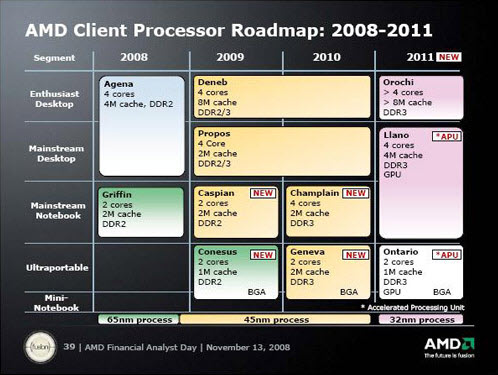AMD's latest roadmaps offer hope - if the company can stick to them!

Yesterday AMD released roadmaps outlining its plans for 2008 to 2011, and they look good. They give a company that seems to have been in a tailspin for several years a glimmer of much-needed hope - as long as it can stick to the roadmap and actually deliver the goods.
Two problems have plagued AMD and resulted in the company delivering quarter after quarter of losses:
- Failure to deliver products in a timely manner. A good example of this were the Opteron server CPUs. Great processors, the only problem was they were a good year behind their time.
- Delivering products at too low a clock speed. A good example of this was the Phenom range of CPUs.
Outdated products + Less than impressive clock speeds = BAD QUARTERS!!!
OK, let's take a look at AMD's roadmaps.

OK, one of the first things that stand out is the delay of "Fusion" combined CPU/GPU package (called an accelerated Processing Unit or APU) until 2011. At last year's financial analyst day AMD announced that a notebook platform called "Shrike" and an APU called "Swift" was supposed to debut in 2009. Not any more. There's no mention of "Shrike" or "Swift." Instead we have to wait until 2011 for the "Llano" and "Ontario" APUs to appear.
But isn't this an indication that AMD can't stick to a roadmap from year to year? Well, only time will really tell, but I think that it makes sense for AMD to wait for the 32nm architecture before pushing out APUs because this will be able to deliver good performance per Watt. This might seem like a house of cards build upon the foundation of getting the 32nm process working and delivering chips, and that's true, but AMD sounds confident.
Putting APUs aside, AMD has four new mobile CPUs in the pipeline.
Two of those are "Conensus" and "Caspian" and both are slated to come out next year. They will feature two cores and DDR2 memory support. "Conensus" should appear during the second half of 2009 as part of the new "Yukon" platform aimed at ultra-portable notebooks and "mini-notebooks," while the "Caspian" powered "Tigris" platform will follow towards the end of 2009 and target mainstream notebooks.
AMD will follow up in 2010 with "Geneva" and "Champlain." Both of these CPUs will support DDR3 memory, and "Champlain" will bring four processing cores to mainstream notebooks. "Geneva," like "Conesus," will be aimed at ultraportable systems and mini-notebooks in a Ball-Grid-Array package (a chip that is soldered directly onto the motherboard). "Conesus" and "Geneva" feel to me as though they are targeting Intel's low voltage Core 2 processors rather than Atom-based systems.
AMD also expects to debut 32nm processors on the desktop in 2011 with "Orochi." Little details on this chip at present, other than it will feature more than four cores, have over 8MB of cache, and DDR3 support (no integrated GPU though).
What was an interesting takeaway from the financial analyst day yesterday was seeing AMD rebrand itself. AMD became successful by appealing to the high-end enthusiast market during the late 1990s, but now AMD has moved away from that an is instead, at least when it comes to the consumer desktop and mobile, concentrating on mainstream value.
Here the message is "See for Yourself." This is supposed to convey the concept that that benchmarks don't sell the end experience, rather visual quality does. Why the shift from performance? Well, while AMD doesn't do very well against Intel in the processor benchmarks, it does when it comes to graphics. Since AMD is focused on platforms it can push an overall experience rather than a set of benchmark results.